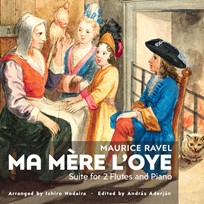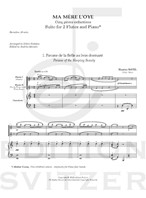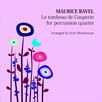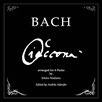
Ma Mère l’Oye
Composer: Maurice Ravel / arr. Ichiro Nodaira
Instrument: 2 Flutes and Piano
Level: Intermediate/Advanced
Published: 2022
Price: €30.00
Item details
-
Description +
-
Preface
„Ma Mère l’Oye“ (Mother Goose), one of Maurice Ravel’s most popular works was composed in 1908 for Piano four hands. The work had such commercial and popular success, that, immediately after its first publication in 1910, it was arranged and transcribed in many versions. Ravel himself orchestrated it in 1911, his friend Jacques Charlot transcribed it for solo piano, and other arrangements soon followed – for flute and piano, cello and piano, string quartet, mixed choir, chamber orchestra, harp, four guitars, wind quintet, piano and wind quintet – and now the present one for two flutes and piano arranged by the Japanese pianist and composer Ichiro Nodaira (*1953).
This arrangement, from 1986, which asks the flautists to play piccolo, flute, alto and bass flute, is dedicated to Michel and Kathy Debost.
András Adorján
Munich, October 2022
-
-
Instrumentation +
-
2 Flutes and Piano
Flauto I: Flauto & Piccolo
Flauto II: Flauto, Piccolo, Flauto in Sol & Flauto Basso
-
-
About the composer +
-
Joseph Maurice Ravel (7 March 1875 – 28 December 1937) was a French composer, pianist and conductor. He is often associated with impressionism along with his elder contemporary Claude Debussy, although both composers rejected the term. In the 1920s and '30s Ravel was internationally regarded as France's greatest living composer.
Born to a music-loving family, Ravel attended France's premier music college, the Paris Conservatoire; he was not well regarded by its conservative establishment, whose biased treatment of him caused a scandal. After leaving the conservatoire Ravel found his own way as a composer, developing a style of great clarity, incorporating elements of baroque, neoclassicism and, in his later works, jazz. He liked to experiment with musical form, as in his best-known work, Boléro (1928), in which repetition takes the place of development. He made some orchestral arrangements of other composers' music, of which his 1922 version of Mussorgsky's Pictures at an Exhibition is the best known.
As a slow and painstaking worker, Ravel composed fewer pieces than many of his contemporaries. Among his works to enter the repertoire are pieces for piano, chamber music, two piano concertos, ballet music, two operas, and eight song cycles; he wrote no symphonies or religious works. Many of his works exist in two versions: a first, piano score and a later orchestration. Some of his piano music, such as Gaspard de la nuit (1908), is exceptionally difficult to play, and his complex orchestral works such as Daphnis et Chloé (1912) require skilful balance in performance.
Ravel was among the first composers to recognise the potential of recording to bring their music to a wider public. From the 1920s, despite limited technique as a pianist or conductor, he took part in recordings of several of his works; others were made under his supervision.
____________
Born in Tokyo in 1953, Ichiro Nodaira studied composition at the Tokyo National University of Fine Arts and Music. In 1978 he was granted a scholarship by the French government to continue his studies at the Conservatoire National Supérieur de Musique de Paris with Henriette Puig-Roget, Betsy Jolas, Serge Nigg, Michel Philippot and Jean Koerner. Later he attended master classes with György Ligeti, Franco Donatoni, Péter Eötvös and Brian Ferneyhough as well as a class in musical computing at the IRCAM in Paris. From 1990 to 2021 Ichiro Nodaira was a professor at the Tokyo National University of Fine Arts and Music. Today he is professor at the Tokyo College of Music, artistic director of the Tokyo Bunka Kaikan, and the AOI Hall in Shizuoka and is active in a double career as pianist and composer. He received the Medal with Purple Ribbon in 2012.
-




